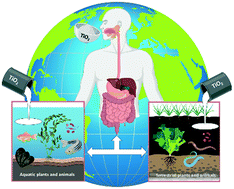Toxicological impact of titanium dioxide nanoparticles and food-grade titanium dioxide (E171) on human and environmental health
Abstract
The widespread use of titanium dioxide (TiO2) as a pigment, mostly in the form of nanoparticles (NPs), for a variety of applications, arouses increasing concerns about its possible impact on human health and aquatic and terrestrial ecosystems. Particularly relevant is the impact of ingestion of this nanomaterial from products containing food-grade TiO2 (E171) as well as food “contaminated” by TiO2 dispersed in the environment. In fact, TiO2 NPs will inevitably leak into the environment and will be transported in water and soil, acting on organisms and ecosystems. TiO2 NPs can pass through biological membranes, enter the cells and accumulate in tissues and organs, exerting toxic effects. Despite the enormous efforts in recent years to better clarify the interactions between TiO2 NPs and the host, differences in experimental approaches and/or controversial results still make it difficult to establish a true perception of risk. To draw a more homogeneous picture of the problem, here we write a critical review of the literature-more than a taxonomic review-selecting evidence of any correlation between the physico-chemical characteristics of TiO2 NPs, their passage through biological barriers, and the impact on human and environmental health.

- This article is part of the themed collection: Environmental Science: Nano Recent Review Articles


 Please wait while we load your content...
Please wait while we load your content...